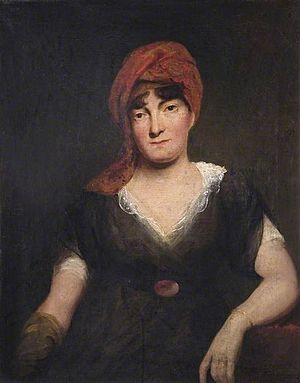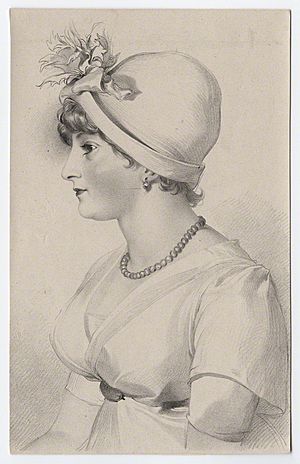Priscilla Kemble facts for kids

Priscilla Kemble (born Priscilla Hopkins; 1756 – May 1845) was a well-known English actress. She was married to the famous English actor John Philip Kemble.
Contents
Priscilla's Family and Early Life
Priscilla Hopkins was born in 1756. Her father, Mr. Hopkins, worked as a prompter at the Drury Lane Theatre for many years. Her mother was also a respected actress in David Garrick's acting company.
Priscilla had an older sister who also became an actress. Her sister first appeared on stage in 1771. She acted successfully for a few seasons before marrying a wealthy man and leaving the stage. She later returned to acting for a short time in 1779 and 1780.
Starting Her Acting Career

Priscilla Hopkins became known as a member of David Garrick's acting company at Drury Lane. One of her first notable roles was Mildred in the play Old City Manners in November 1775. She also played Fanny in Clandestine Marriage and Maria in Maid of the Oaks that same year.
In 1776, she created the role of Harriet in Hannah Cowley's play Runaway. She also played Eliza in Colman's Spleen, or Islington Spa. The next season, she acted as Sylvia in Old Bachelor.
Priscilla was the first actress to play Kitty Sprightly in All the World's a Stage. On May 8, 1777, she became the first Maria in the famous play School for Scandal. She also performed in other plays like Every Man in his Humour and The Provoked Wife.
Priscilla was considered very pretty and lively. She married William Brereton (1751–1787), who was also an actor at Drury Lane.
Her Later Acting Roles
After her marriage, Priscilla began performing as Mrs. Brereton. Her first role under her new name was Louisa Dudley in The West Indian on October 8, 1778. She continued to play many important supporting roles on stage.
Some of her roles included Lady Constant in The Way to Keep Him, Charlotte in The Gamester, and Sylvia in The Double Gallant. She also played Elizabeth in Mrs. Cowley's Who's the Dupe? and Mariana in The Miser. Other parts were Perdita, Amanda in Trip to Scarborough, and Fidelia in The Foundling.
She also played Angelina in Love Makes a Man, Rose in The Recruiting Officer, and Maria in Twelfth Night. In 1786, she was the first Donna Viola in Mrs. Cowley's School for Greybeards. She also played Margaret in A New Way to Pay Old Debts.
William Brereton, her first husband, passed away on February 17, 1787. He was buried in Shoreditch churchyard.
On December 8, 1787, Priscilla married John Philip Kemble. She then began acting as Mrs. Kemble. Two days later, on December 10, she appeared as Lady Anne in Richard III. Her next role was Hero in Much Ado about Nothing. She also created the roles of Aurora in Kemble's Pannel and Flora in his Farm House.
In 1788, she played Lady Lambert in The Hypocrite. In 1790, she was Sylvia in Two Gentlemen of Verona. She also created the role of Valeria in her husband's play Love in many Masks. She continued to perform with the company at the Haymarket Opera House. In 1792, she was the first Miss Manly in Richardson's Fugitive.
Life After Acting
Even though she was married to John Philip Kemble, Priscilla found that she was not given many important acting roles. Because of this, she decided to retire from acting on May 23, 1796. Her last performance was as Flavia in Kemble's play Celadon and Florimel, or the Happy Counterplot.
After her husband retired, Priscilla traveled with him. After his death, she moved to Leamington. She was a popular person and stayed mentally sharp until she passed away in May 1845. She was 90 years old.
Priscilla Kemble did not have any children. Her belongings and property were left to members of the Kemble and Siddons families. People who knew her said she was pretty and performed best in roles like Maria in The School for Scandal.
Sources
![]() This article incorporates text from a publication now in the public domain: Knight, John Joseph (1892). "Kemble, Priscilla". Dictionary of National Biography 30. Ed. Sidney Lee. London: Smith, Elder & Co.
This article incorporates text from a publication now in the public domain: Knight, John Joseph (1892). "Kemble, Priscilla". Dictionary of National Biography 30. Ed. Sidney Lee. London: Smith, Elder & Co.

